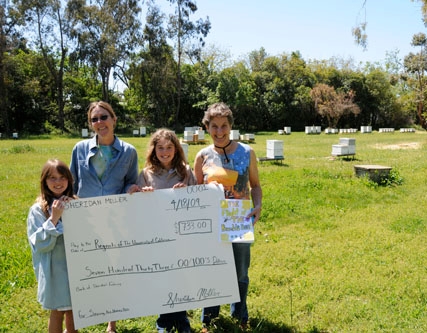- Author: Kathy Keatley Garvey

The declining honey bee population and the increasing need for honey bee research prompted her to raise $733 and donate it to the Department of Entomology, University of California, Davis. To earn the money, she sold jars of honey, baked goods featuring honey, beeswax candles, olive oil, soap and a self-penned booklet about the plight of honey bees.
Sheridan and her parents, Craig and Annika Miller and sister, Annelie, 8, recently traveled from their home in Marin County to the department's Harry H. Laidlaw Jr. Honey Bee Research Facility on Bee Biology Road to deliver an oversized check and to take a tour of the facility.
“It's very thoughtful and generous of a little girl to think of the plight of the honey bees and to raise funds for research,” said Lynn Kimsey, professor and chair of the Department of Entomology and director of the Bohart Museum of Entomology. “We are overwhelmed.”
Said Cooperative Extension Apiculturist Eric Mussen, a member of the UC Davis Department of Entomology since 1976: “I really appreciate the fact that so many members of the general public have become concerned about the plight of honey bees. I am particularly impressed by individuals such as Sheridan who have devoted so much time and effort in really trying to improve the health and longevity of the honey bees.”

The young author, a fifth grader, sold the booklet for $7, with all proceeds going for honey bee research at the Laidlaw facility.
“I learned about bees in the fourth grade and then did research on the Internet,” Sheridan said. She gleaned information from the UC Davis Department of Entomology Web site (http://entomology.ucdavis.edu/) and the Haagen-Dazs Web site (www.helpthehoneybees.com), launched in February 2008 to create awareness for the plight of the honey bee. A neighbor provided her with honey to sell. At a bake sale, Sheridan raised funds by selling a variety of food and non-food items and also took orders for her booklets. Sister Annelie assisted with the fundraising.
“Honey bees pollinate delicious fruits, vegetables and even nuts,” Sheridan wrote in her booklet. “If they were to disappear, our food source would consist of wheat, rice and corn.”
She included an Albert Einstein quote: “If bees were to disappear off the surface of the earth, mankind would have but four years to live.”
Her father, a San Francisco-based lawyer, and her mother, a tutor and former teacher, were delighted to see their daughter carry through with her project. “She learned a lot about honey bees in the process,” Annika said.
The Millers learned even more about honey bees on their trip to UC Davis. Bee breeder-geneticist Susan Cobey, manager of the Laidlaw facility, and Kimsey guided them through the Laidlaw facility and apiary.
Cobey opened a hive and showed the Millers the queen bee, worker bees (females) and drones and let them sample honey. Cobey also broke off a chunk of recently drawn beeswax comb for them to examine and take home.
Sheridan presented Kimsey with a copy of her booklet, which points out that “UC Davis has been actively researching honey bees for 76 years.”
The booklet lists 20 bee facts, including:
--The honey bee has been around for 30 million years
--The average honey bee will only make one-twelfth of a teaspoon of honey in its lifetime
--It takes about 556 workers to gather one pound of honey from about 2 million flowers
--Worker honey bees are females, live 6 to 8 weeks and do all the work
--Honey bees will usually travel only 3 miles from their hive
The recipes in the booklet showcase honey as a key ingredient. They include Honey Oatmeal Muffins, Honey Crispies, Honey Banana Bread, Honey Nut Bread, and Honey and Lemon Green Tea Cupcakes and Honey Breadsticks.
If you bake with honey, Sheridan wrote, “please buy only local, organic honey that has not been shipped. Thank you.”
Sheridan now hopes others will join the cause to “save the bees.” Her booklet lists ways to help: Plant a bee friendly garden; try buying only organic fruits and vegetables; never use pesticides for gardens; and become a backyard beekeeper.
A backyard beekeeper? That's her next goal.
“I'd like a hive for my backyard,” Sheridan said.



